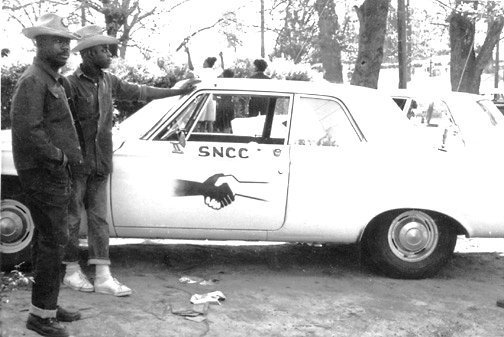

Historian Travis Wright teaches us about the Sojourner Motor Fleet. A taste:
On a late summer night in 1964, a small plane landed on a desolate airstrip outside Greenwood, Mississippi, carrying two of the civil rights movement’s most prominent supporters—Harry Belafonte and Sidney Poitier. The well-known Black entertainers were delivering much-needed cash to the Student Nonviolent Coordinating Committee (SNCC). Waiting for them were James Forman, SNCC’s executive secretary, and field worker, Willie Blue, in a SNCC-owned Pontiac, sanded down to prevent it from shining in the night. Southern activists routinely manipulated their cars to evade white racists on backroads and highways, though it was not always successful. As Belafonte later noted, it was “a good precaution, but not good enough.” Indeed, as the organizers drove away from the dark airfield, a line of pickup trucks appeared in the distance, headlights glaring. “That’s the Klan,” Willie stated.
As the SNCC workers neared the line of pickup trucks, they swerved off the road, hoping to lose their pursuers by taking an alternate route into town. The Klan trucks followed, however, ramming the SNCC car from behind. “We can’t let them pull up beside us” Willie shouted. “They’ll shoot.” Willie radioed the local SNCC office to alert them and request backup. “We’re on the way,” a voice replied. After several tense minutes of trying to outrun the Klan, the SNCC workers spotted a large convoy of cars speeding toward them from Greenwood. “That’s them,” Willie and Belafonte shouted, “the SNCC brigade to the rescue.” As the fleet of cars approached, the trucks slowed before eventually retreating. Belafonte and Poitier made it out alive that night, thanks to SNCC’s Sojourner Motor Fleet.
Most cars were donated by supporters throughout the North, reflecting the widespread material support that underpinned the movement. As the narrow escape of Belafonte and Poitier illustrates, these cars could make the difference between life and death for civil rights workers navigating the dark and isolated roads of the rural South. Beyond safety, the fleet significantly expanded SNCC’s capacity to conduct voter registration drives and mobilize communities by reaching remote areas. Despite its indelible role in the struggle for civil rights, however, the fleet—and the broader ways resources like cars impacted Black organizing—largely remain overlooked in the historiography of the Black freedom struggle. This historical gap reflects a broader tendency to under-analyze the logistical work of movement building and resource mobilization, which often occurred behind the scenes, away from the public eye.
To understand why the Sojourner Motor Fleet was so crucial, it is essential to consider the unique challenges SNCC faced in the rural South. Unlike urban centers such as Montgomery and Birmingham, where civil rights organizations could rely on existing community infrastructure, SNCC operated in isolated areas with scattered populations and limited resources. In cities, groups like the Southern Christian Leadership Conference (SCLC) could tap into networks of Black churches, businesses, and resources from the local community to support the movement. This was evident during the Montgomery bus boycott, where community leaders organized a carpool system to ensure Black residents could get to work. By contrast, SNCC faced immense logistical challenges in the rural South, where communities were scattered, and residents were predominantly poor farmers with limited resources.
Read the rest at Black Perspectives.